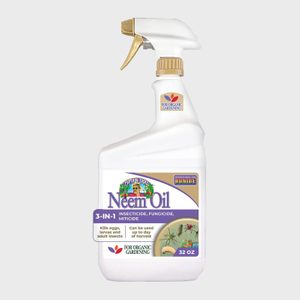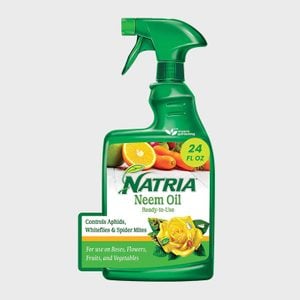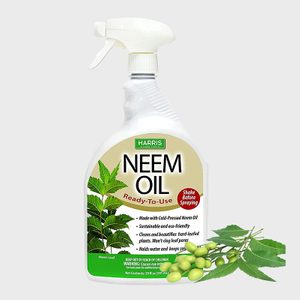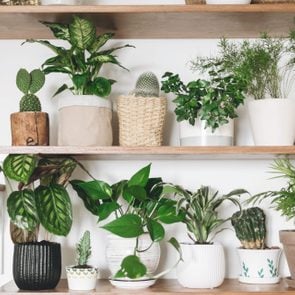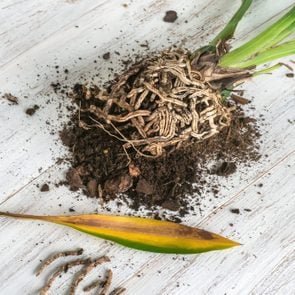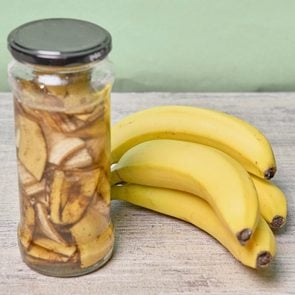How to Use Neem Oil on Plants to Protect Against Pests
Updated: Mar. 14, 2024

Knock out nasty plant pests with the natural, safe and environmentally friendly pesticide neem oil
Discovering icky insects binging on your prized plant’s leaves can induce panic in the heart of any gardener. But getting rid of aphids or other plant pests is all about being calm and nipping the problem in the bud—before you end up with a dead plant. Frequently, hosing down your indoor plants with water can be enough to eradicate the hangers-on. But, if an infestation is out of control, you might be considering neem oil for plants to help you get rid of spider mites or other bothersome bugs.
You can easily pick up a chemical pesticide from your local garden center. But if you’d rather avoid harmful chemicals that can be risky for people, pets and the environment, there are low-impact alternatives like neem oil to help you get rid of mealybugs or other creepy crawlies. Master gardener Beth Buckley explains that, as far as pesticides go, neem oil is one of the better ones. “It’s naturally occurring, low in toxicity and has a long history of use,” she says. Check out these expert-approved tips for how and when to use neem oil to banish the bugs.
Get Reader’s Digest’s Read Up newsletter for more gardening, humor, cleaning, travel, tech and fun facts all week long.
What is neem oil?
Neem oil is a naturally occurring pesticide coming from the seeds of the native South Asian neem tree (Azadirachta indica). It’s also used in traditional Ayurvedic medicine, and you can find it in things like heating fuels, soaps, cosmetics and toothpaste. The main active ingredient within the oil enabling it to work as a pesticide is azadirachtin.
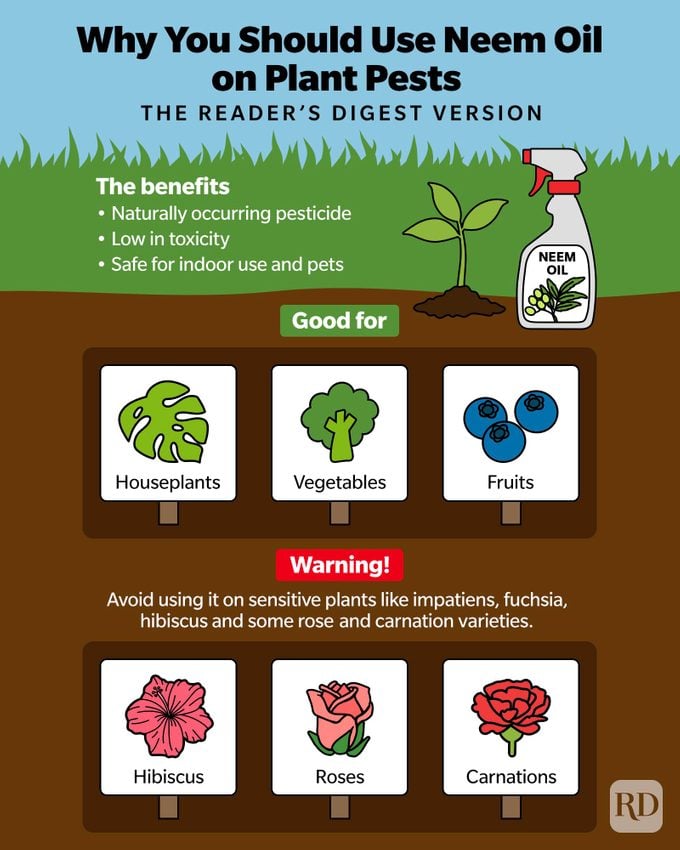
How does neem oil work on plants?
You can use neem oil to control infestations of common houseplant pests. These include aphids, spider mites, beetles, mealybugs, thrips, whiteflies and leaf miners. It’s effective during their immature phases, but it won’t kill adult bugs. Plus, “insects that have hard bodies or protective shells (like scale) are completely unbothered by neem oil,” Buckley says.
“Azadirachtin works by inhibiting pest metabolism and hormones, and the oil can literally smother soft-bodied insects,” she explains. The oil blocks the breathing pores of the pests in the same way that an insecticidal soap does. The azadirachtin interrupts feeding, growth and reproduction in the insects when they eat it and acts as a repellent.
However, “azadirachtin must be ingested by an insect to be effective,” Buckley says. “If the pest does not feed on leaf tissues—like root mealies, for example—it won’t ingest any neem.” And immediate results are rare. Repeated applications are typically necessary to wipe out a bug invasion.
Studies also show neem oil effectively limits the spread of the common fungal diseases rust and powdery mildew.
What plants benefit from neem oil?
You can use neem oil on a wide variety of plants, vegetables and fruits as part of your pest-management strategy. But it always pays to test on a small area of an individual leaf before smothering all a plant’s foliage in this stuff. You should avoid using neem oil on recent transplants or plants showing signs of stress.
If in doubt, Buckley recommends exhausting other natural pest-management options before turning to neem oil for plants. “In my opinion, the safest, most natural and best way to treat pests on plant leaves is with a strong blast from the hose,” she says. “Using beneficial predatory insects is another great [option]. Lacewings, soil mites, nematodes and many others are great at keeping pests in check.”
What plants should you not use neem oil on?
Some trees, including black walnuts, Douglas firs, junipers, maples, redbuds and spruces, are sensitive to horticultural oils such as neem. And there are precautions for use on sensitive plants, which include impatiens, fuchsia, hibiscus and some rose and carnation varieties. Neem oil is more likely to burn and damage their foliage.
Plus, when plants have textured foliage, like calatheas, results might not be as effective because it’s tricky to get complete oil coverage. This makes it easier for bugs to escape a smothering or munch on oil-free sections of foliage.
Depending on how sensitive your sense of smell is, you might want to stick with using neem oil on outdoor specimens rather than your indoor plants. “Neem oil stinks,” Buckley says. “Some folks don’t mind it, but in my opinion, the strong sulfur/rotten onion smell is very unpleasant, especially for indoor use.”
How do you use neem oil for plants?
Carefully follow the manufacturer’s instructions when applying a commercial neem oil spray for plants. Going the DIY route is also possible by making your own non-toxic pesticide.
Make your own neem oil spray
Mixing your own neem oil spray for plants is straightforward. Plus, it offers more control over strength and additional ingredients. Follow the steps below to blend and apply your bug-busting mixture.
Step 1: Create a soapy water mixture
Fill a one-liter spray bottle almost to the top with tap water. Mix in 1/4 to 1/2 teaspoon of mild dish soap. Adding the emulsifying soap is an important step to help improve the neem oil’s solubility in water. Shake the bottle well.
Step 2: Add neem oil to the mix
A little goes a long way with concentrated neem oil. Add 1 to 2 teaspoons to the soap-and-water mix and shake thoroughly to blend until it has a cloudy appearance. Using warm (not hot) water helps the neem oil blend better.
Step 3: Test the spray
Don’t douse your plant straight away with the spray. Check its sensitivity and the strength of the solution by testing on a small section of one leaf. Then wait 24 hours. If the plant shows signs of damage or discoloration, try diluting the solution further or opt for an alternative pest-management strategy.
And even if your plant hasn’t objected to neem oil application before, it’s always advisable to retest. Some plants can be more sensitive at certain times of the year.
Step 4: Spray the plant’s surface with care
Don protective gloves before spraying the surface and underside of the plant’s leaves. A light, even coating rather than a smothering is best to ensure your plant can fully absorb the light it needs and to minimize the chance of soaking leaves starting to rot or develop fungal problems. Consider also gently rubbing the spray into the leaves to promote the best coverage. The coating should take around 30 minutes to an hour to dry.
Step 5: Make a fresh mixture when reapplying
You will probably have to reapply the spray to eradicate all the bugs on your plant. Dousing daily for a week is sometimes the best strategy when there are hordes of creepy crawlies. When your plant doesn’t have too many tiny visitors, a treatment once every week should be ample.
The active ingredients in DIY neem oil sprays for plants lose their effectiveness fairly quickly once blended with water. Don’t mix up a huge batch all at once. It’s best to just keep enough for using over the next day or two.
Buy a neem oil spray
Frequently asked questions
When should you use neem oil for plants?
Spraying plants with neem oil at dusk or dawn is best. That way you’re less likely to risk harming beneficial pollinators like bees. It also reduces the chance of your plant developing brown tips on the leaves because of scorching when the neem oil dries under direct sun.
You can apply neem oil in any season, but avoid using it during extreme temperatures—above 100 degrees or below freezing. Wait for a dry day too, as the oil won’t evaporate well when wet.
How much neem oil do you use for plants?
Neem oil is a concentrated product. Using too much can result in leaf scorch or other damage to your plant. When making your own spray for plants, a ratio of around 1:100 (one part neem to every 100 parts water) usually works.
Can I put neem oil directly on soil?
Applying a neem oil mix as a soil drench when you’re watering your plants is another way to ward off pests. The roots absorb the active ingredients, and the insects still get them into their system when eating the leaves.
Is neem oil safe for pets?
“Azadirachtin can be slightly irritating to your skin or eyes if it comes in contact with them, but in general, it’s one of the safest pesticides to use indoors or around pets,” Buckley says.
When applying the spray, it’s best to have your pets in another room. But if your pets nibble on foliage sprayed with neem oil, unless it’s a plant that’s poisonous for dogs or you have a houseplant that’s toxic for cats, it isn’t a major cause for concern.
Next, also learn how to use rice water on plants to make your garden thrive.
Sources:
- Beth Buckley, master gardener
- National Library of Medicine: “Neem: A Tree for Solving Global Problems”
- Colorado State University: “Insect Control: Horticultural Oils”
- University of Nevado, Reno: “Horticultural Oils – What a Gardener Needs to Know”




















